A year or so ago, I was taking pictures at a “teen dog social,” which was attended by some 6-month-old dogs I had last seen a few months prior. All of the dogs were maturing into well-mannered young adults – but I worried about two of them. Most of the young dogs present were in good condition, but two were absolutely obese! How does such a young dog get so fat?
My friends know that overweight dogs are one of my pet peeves. (In fact, I very nearly lost my best friend when, shocked, I blurted, “Oh my gosh, how did Carly get so fat?!” when I hadn’t seen her dog for a long time.)
I’m overweight, myself – but it’s something I control; I am solely responsible for the negative effects that being overweight can have on my health. Our dogs, in contrast, can’t be held responsible for their weight and condition; we alone are at fault when we allow them to get fat and end up with health problems associated with obesity: an increase in cancer, high blood pressure, type II diabetes, kidney disease, osteoarthritis, and more.
Obesity in young dogs is even worse: by making dogs carry extra weight on as-yet immature joints and bones with open growth plates, it predisposes the dog to a much higher risk of painful osteoarthritis later in life. Fat young dogs are also at a higher risk of other orthopedic problems – cranial cruciate ligament (CCL) injuries, in particular.
Given the fact that both of the fat young dogs were Labradors – high-energy goofballs – I felt compelled to mention these risks in particular to their owners. (There she goes again!) This time, I didn’t blurt it out; I was tactful. But even so, both sets of owners were shocked; they knew their pets would mature to be “big” dogs and they thought the bulk was just “puppy fat.”
Here’s the clincher: In their defense, both owners said, “We just feed the suggested amount on the label!”
RECOMMENDED FEEDING GUIDELINES
You don’t have to read to the end of this piece; here’s the most important information to take away from this story: You should never feed your dog according to the product’s feeding guidelines without adjusting the amounts to suit your dog!
Dog food manufacturers are required by law to put feeding instructions on their labels, to give dog owners a starting point – an idea of approximately how much of the product should be fed to provide “complete and balanced nutrition” to dogs of varying weights. The feeding directions must state, at a minimum, “Feed (weight/unit) of product per (weight) of the dog.”
These numbers are derived through a calculation that estimates the caloric content of the food and factors it against the average, medium-size dog’s “resting energy requirements” (RER), which represents the energy requirement of a dog at rest at a controlled temperature. The accepted formula for calculating a dog’s RER is 30 times the dog’s body weight in kilograms plus 70. The calculation for a 40-pound (18.14 kg) dog would look like this: 30 x 18.14 + 70 = 614.2 calories.
That might seem helpful to know, but be advised that many factors can affect a particular dog’s RER. Is the dog neutered or spayed? If so, his or her RER will be less. Is the climate very cold? If so, the dog’s RER will be more. Inactive dogs and very large dogs have lower caloric requirements, per pound of body weight. Highly active dogs and small dogs need more calories, per pound of body weight, than the average dog.
The dog’s age also affects his RER. Did you know that puppies require more calories than adult dogs who weigh the same amount? Puppy foods usually show a more complex table for their feeding instructions, one that shows both the puppy’s weight and age. Note that the recommended feeding amount goes down as the dog gets older.
So, good feeding instructions will add something like, “Feeding rates should be adjusted based upon breed type, activity, or environmental conditions.”
The very best feeding instructions will expand even more on this point. Stella & Chewy’s label says, “The table below shows the number of measuring cups to feed each day based on a pet’s weight. Please note these are guidelines, and individual requirements can vary by +/-50% based on your pet’s activity level, metabolism, age, general health, and other factors.” Plus or minus 50%!!
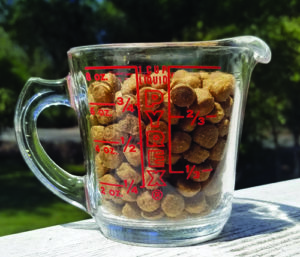
- A measured cup of one food may not contain, by weight, the same amount of food as another measured cup. If the kibble size is very small, the spaces between the nuggets will be smaller, too, resulting in more food by weight in the same volume of space.
- If you use a coffee cup to scoop and measure your dog’s food, be advised that you are likely feeding him more than “one cup” of food; most coffee cups hold more volume than one measuring cup full.
- Kibble is highly nutrient-dense. Whatever cup or scooper you use, be aware that a rounded, over-full scoop will contain a lot more calories than a level scoop. (This is one of the hazards of asking kids or the most soft-hearted member of the family to feed the dog; they tend to overfill the scoops.)
- Weighing your dog’s portions is more precise than using an approximate volume of food. That said, be advised that the caloric content of foods can vary widely; 8 ounces of this food might contain 280 calories, whereas 8 ounces of that food might contain as much as 500 calories. So when you change foods, check the caloric content, and adjust your dog’s portion accordingly.
GETTING PAST THE STARTING POINT
Now you know: The amounts given are just a starting place. So how should you adjust the feeding suggestions in order to give your dog an appropriate amount?
Research scientists have worked out some formulas so one could conceivably multiply any dog’s RER by factors that have calculated for activity and inactivity, cold climates, neuter status, etc. But you don’t need to be a mathematician to work this out! All you need are your eyes and hands. Look at and feel your dog!
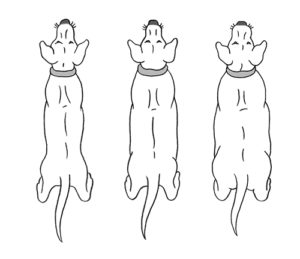
When you look at your standing dog from above, you should be able to see a discernible waist, with an hourglass indentation between his ribs and his hips. If your dog is super fluffy, you have to feel for this indentation. If he feels like a sausage (a straight tube) or a lemon (wider in the middle than at the ends), he’s fat.
While you’ve got your hands on your dog, see if you can feel his ribs. Then, take the “knuckle test”: Make a loose fist with one hand. Run the fingers of your other hand across the back of the hand with the fist, then over the knuckles, then over the back of your fingers near the knuckles. If your dog’s ribs feel like the back of your hand, where you can barely feel the bones, your dog is likely too fat. If your dog’s ribs feel like your knuckles, he’s likely too thin. If his ribs feel similar to the backs of your fingers near your knuckles, where you can feel each rib but they are slightly padded, he’s probably at a good weight.
If you discern that your dog is overweight, reduce the amount of calories that you feed him! And, if you both are able, increase his exercise. That’s the super-short version of an article we’ll bring you in a future issue on strategies for safe weight-reduction. But if your dog is fat, don’t wait to get started: Cut his portion size now!


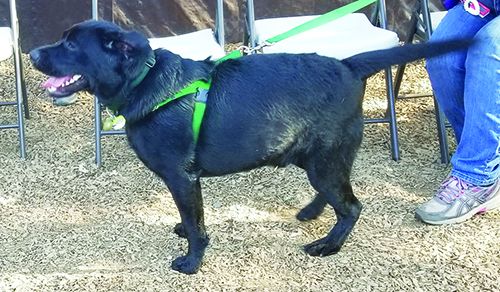
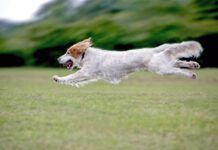

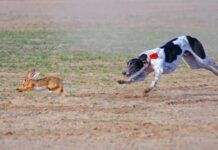

If I may correct you, cats get type II diabetes, dogs unfortunately, get type I. An obese dog with diabetes will require higher doses of insulin than if his/her body weight were lower, however. The information was provided to me by a veterinarian who is an expert in metabolic disorders of pets (and is a reseacher), as I was surprised when my dog was diagnosed (and she was, and still is, at her ideal weight).
This was crazy confusing!
True
This was crazy confusing!
When did I comment before..never!
Sadly, and obviously since there are so many obese or super skinny animals out there, feeding any animal can be confusing. The advice here is good, but there are a few things I think that are key that are not mentioned.
First….TREATS! I believe this to be the biggest issue for people when it comes to dogs being overweight. Especially in the days of crating dogs, and treat training. Even if you are giving your dog the correct amount of kibble/raw/wet food, if you are giving your dog a ton of treats or treat training your puppy, this can put them over the top. Often merely cutting down on the treats can be enough to drop their weight. I personally prefer to give my dog less kibble and allow for the treats because who wouldn’t prefer to have a snack in the middle of the day rather than go all day without eating anything between meals. As people we eat throughout the day, why we think a dog is different is beyond me. They are not wild animals and have adapted to our environment, thus a few small, healthy, treats throughout the day can keep there metabolism going. The long and short here is if you treat your dog a lot then cut back either on the treats or the kibble but one or both need to be curbed if your dog is fat. Oh and fat puppies are horrible! It is the worst thing you can do, and if you do not correct it they will fight weight for their entire shortened life because of obesity. Don’t do it!
The next is the quality of the food and how fast your dog eats the food. If you can use a puzzle bowl for the fast eater it will teach them to eat slower, this in turn is more satisfying for the dog, and allows for better digestion of the food. Ideally dogs should be able to have food readily available so they can self regulate on their own, however very few dogs can do this and it is hard if you have more than one dog, thus we feed once or twice (I think twice is way better than once) a day.
The quality of the food is also important, as many foods have fillers that make them fat. Foods full of fillers are not satisfying for the dog, require more food for the calories and produce more waste. Think of fast food, if you eat McDonalds all the time it’s bad for you and would cause all sorts of health issues if that was all you ever ate. Once in a while is fine, but most people typically feed dogs the exact same food for their entire lives (another bad idea but I have to stop at some point) so think about what you are giving your dog and choose wisely since this is their only source of valuable fuel, and makes a difference in weight, coat, health, energy level, teeth, amount they poop, and the list goes on.
That’s my 10 cents (since it was long) 🙂 And FYI I have had dogs, horses, cats, and caged pets my entire life. None of my animals have been obese or too skinny, and my dogs are fed a combo of kibble and home made food. Yes I am nuts, I make food for my dog. But it is cheaper for the quality, and it’s not that hard.
I could’ve written this article . As a retired groomer of 50 years it was also my pet peeve . I and many groomers see dogs in terrible health and pain due to obesity . I have tried many approaches to try and help but rarely if ever have an owner change their behavior . Eventually I would give my basic talk , which included several suggestions including measurement of the food etc. .People overfeed their pets because of their own feelings , not for the health of the pets . It just seems so simple to me if you truly love them you will do what’s best for them .
Check out Hungry Pet on the Apple app store. It will help you determine the correct amount to feed.
What besides meat is a good homemade ingredient for American bull dogs that are on the fat edge. And I am already seeing the impact on their joints and it is not good. I give them fresh turkey about 8 days a month. And raw beef liver about 5 days a month . With their kibble and wet food. They are 81/2 years old , cut, and usually active like walking most every day at least 2 or 3 miles a day. Any suggestions
Took me a few reads to get the back of the hand / knuckles test, however now that I get it, yes! Fabulous physical / touch discernment.
What is a good food for a Frenchie with a sensitive digestion system?
I have been struggling to feed my Golden Retriever mix (husky and red healer) properly since I got her a year ago. She was 3 yrs. 48 lbs. and totally undernourished. The vet said she should be 60 – 65 lbs. She was so happy to be eating I kept feeding her kibble and boiled chicken. When I took her back to the vet she was 70lbs. I started feeding her less, weighing her food, etc. and she kept wanting to eat. She is now 77lbs. She was very traumatized and will not play with the other dogs at the dog park. She never runs or trots; she walks slowly for about an hour and a half a day. She is afraid of balls and she won’t play. I had 2 big dogs that I ran with but I can’t run anymore (my age). I never thought about a dog getting fat. I never had that problem. I am now feeding her canned and kibble (less than half of the suggested amount). I give her 2 mini dog biscuits and a pork chew to keep her from chewing on her paws and legs. I thinking about going to a different vet and have them help me with this. She is not a ravenous eater. I would like her to lose the weight without feeling hungry. So this is my sad story. On the upside, she is a happy dog, always smiling and affectionate.
Hi, how are you doing.
Hi there yeah for my dog I just to feed her morning and night and she was overweight and my bet told me to feeds her 1 time a day and that helps my dog…